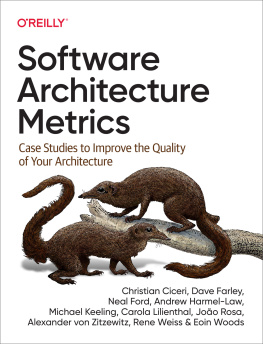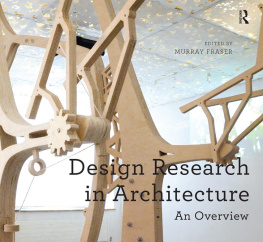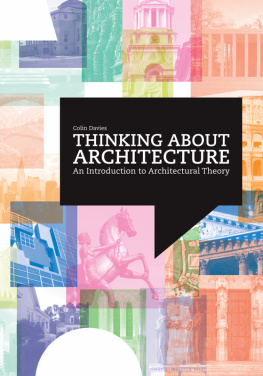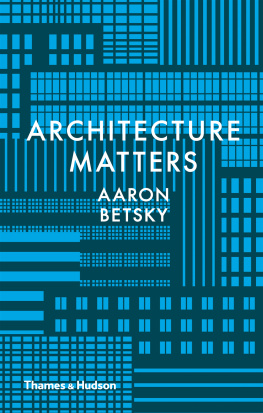

Kenneth Frampton
Elsa Lam and Graham Livesey
Marco Polo and Colin Ripley
George Thomas Kapelos
Lisa Landrum
Odile Hnault
George Baird
Larry Wayne Richards
Ian Chodikoff
Steven Mannell
Sherry McKay
Graham Livesey
Brian Carter
Lola Sheppard and Mason White
David Theodore
Elsa Lam
Adele Weder
Foreword
Kenneth Frampton
This survey of Canadian architecture covering half a century of development, from Expo 67 in Montreal to works from the first decades of the twentieth century, may be seen as a delayed recognition of the wide-ranging scope of Canadian architecture over the past fifty years. Unlike the earlier half-century of creativity in the United States, lasting from 1945 to the millenniumthat is to say from the swan song of the New Deal to the postwar euphoria of the Pax Americanathe first indications of a similar fertile moment in Canada began with Ron Thoms Massey College, patently derived from the Oxbridge model but nonetheless a subtle rptition diffrente realized for the University of Toronto in 1963.
Four years later at Expo 67, the worlds attention was drawn to Canada by an exceptionally audacious work: namely Moshe Safdies Habitat 67, an eight-to-twelve-story assembly of garden apartments, ranging from single-story units to duplexes, ingeniously poised on top of a giant reinforced concrete superstructure in such a manner that the top of one apartment served as the roof terrace for the next. This updated Babylonian image had the effect of putting Canada on the world map as far as architecture was concerned. Moreover, Habitat 67 was more than a match (symbolically and otherwise) for the overbearing geodesic sphere of Buckminster Fullers US Pavilion. Safdies avant-gardist audacity in Montreal was answered by the University of Torontos Scarborough College, completed one year before as a serpentine city-in-miniature to the designs of the then-migr Australian architect John Andrews.
Around the same time in Montreal, there was another significant but self-effacing achievementnamely Ray Afflecks Place Bonaventureexecuted in the same bush-hammered corduroy concrete as Paul Rudolphs Art and Architecture Building in New Haven of 1963. Accompanying the ingenious hotel atop a six-story merchandise mart was a secret paradise garden by Sasaki Associates.
Equally inventive, however much it may have been inspired by Shadrach Woodss Free University in Berlin of 1963, was Eberhard Zeidlers McMaster Health Sciences Centre, completed in Hamilton, Ontario, in 1972. This unique hospital would be matched by the same architects equally brilliant Eaton Centre of 1977, which remains, even now, a seminal if insufficiently valued contribution to the received repertoire of urban design.
Something similar may surely be claimed for Arthur Ericksons Simon Fraser University, designed with Geoffrey Massey in 1963, and built just outside of Vancouver over the following decade. Equally prescient was his Robson Square development, built twenty years later in downtown Vancouver, which was not in fact a square at all, but a multilevel mega-structure that, by virtue of its mixed-use programming, served as a catalyst for the revitalization of a decaying downtown. This idea of inserting a linear space of public appearance as a cultural catalyst in an otherwise all but totally privatized environment had, in fact, been broached a decade earlier on the Canadian scene, and indubitably rationalized in part as a reasonable response to an exceptionally harsh climate. This was accomplished by the remarkable student dormitories designed in 1971 for the University of Alberta by the migr American architect Barton Myers: the one-off piece known as the HUB building was, in effect, an elevated, top-lit galleria flanked on both sides by five-story student residential accommodations.
The more overtly regional aspects of this anthology come to the fore in chapters such as one devoted to the work of those Canadian architects who have dedicated themselves to serving First Nations of the country, particularly as part of a nationwide, government-backed cultural endeavor that has yet to find its parallel in the United States; such is the tragic scale of the initial American genocide and the systematic maltreatment of the native population ever since. This chapter focuses on works designed specifically for the aboriginal population of Canada, with a more heightened sensitivity perhaps in British Columbia than in any other province. One thinks in this regard of the Seabird Island School, designed by Patkau Architects and completed in Agassiz, British Columbia, in 1991. It was built by a First Nations community after a meticulous scale model in wood (which was designed and fabricated by the architects themselves); this device allowed the community to realize the school without needing to have recourse to drawings. This heroic work testifies to a particularly civilized moment in Canadian history, when an enlightened bureaucracy could momentarily back a federal policy of allowing native peoples to build subsidized schools directly for their own occupation.
Elsewhere in Canada, a sensitive approach to the culture of the countrys rural landscapes is demonstrated by contemporary practitioners, including Brian MacKay-Lyons, whose work at Shobac is particularly notable, comprising a collection of neo-vernacular structures grouped together in Upper Kingsburg, Nova Scotia, and erected in the space of a decade. Equally seminal has been the work of Brigitte Shim and Howard Sutcliffe, whose realizations in Toronto include the Residence for the Sisters of Saint Joseph of 2013, a commission that demonstrates their propensity for typological invention. The late Dan Hanganus housing and urban buildings combine an industrial aesthetic with sensitivity to sites layered historical contexts, particularly evident in his Muse Pointe--Callire in Old Montreal of 1992.
This anthology, edited by Elsa Lam, editor of Canadian Architect, and by professor Graham Livesey of the University of Calgary, amounts to a major achievement of collective scholarship. It comprises the contributions of seventeen scholars representing successive generations of Canadian intellectuals in the field, ranging from academics to critics and to architects and, in many instances, individuals who are all three. By any standards, this is an encyclopedic tour de force documenting fifty years of Canadian architectural production across the expanse of what is still a sparsely populated continent. The result is a selection of several hundred notable buildings of widely varying provenance. The work featured in these pages is surely what it takes, over time, to arrive at a national culture of architecture worthy of the name. It is a privilege for me, as an aficionado of Canadian architecture, to contribute to this anthology in the form of this foreword.
Introduction
Elsa Lam and Graham Livesey
In his magisterial A History of Canadian Architecture, Harold Kalman devotes only one of fifteen chapters to modern architecture. And yet it can be argued that distinctively Canadian architecture only emerged midcentury and fully blossomed after 1967, Canadas centennial year. As a result of the countrys long colonial history, earlier architecture tended to be derivative of styles from the United States and Europe.
The first truly modern Canadian works of architecture appeared in the 1940s and 1950s in and around Vancouver. The West Coast Style, apparent in houses such as the 1942 residence in West Vancouver designed by modernist artist B. C. Binning (19091976) for himself, was influenced by trends in California and in the Pacific Northwest, but was adapted to the areas particular climate and plethora of sites perched between forested mountains and expansive ocean.
Next page






